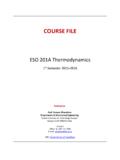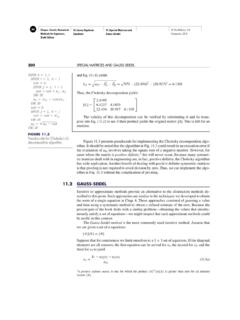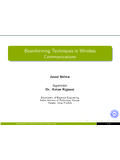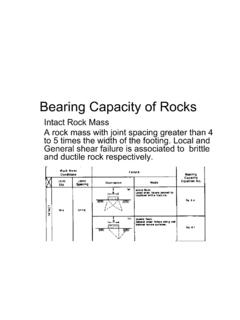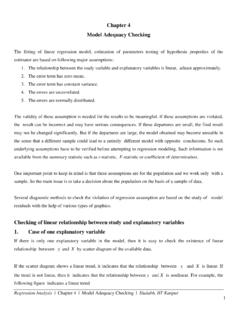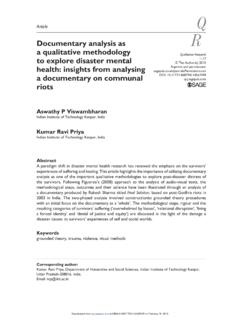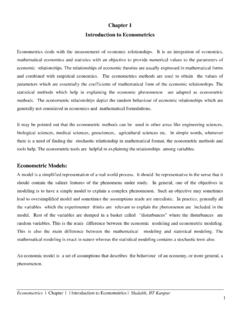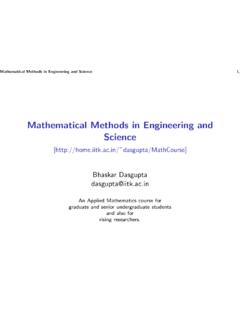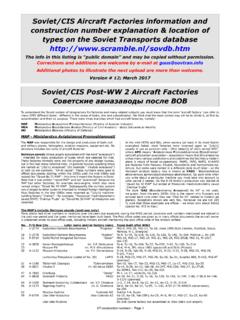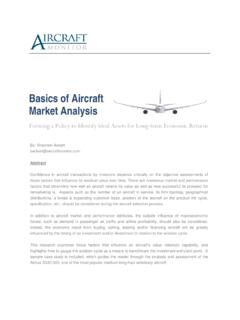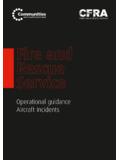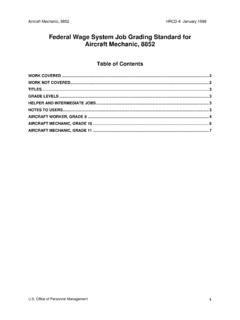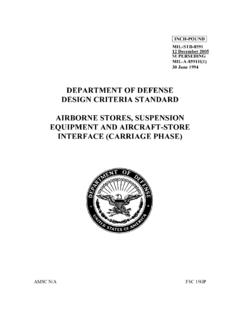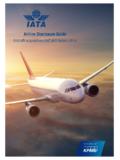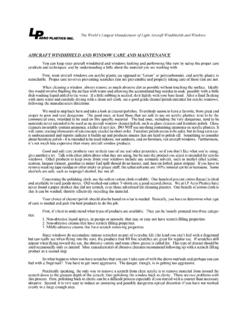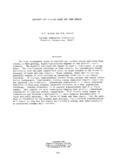Transcription of AIRCRAFT BASIC CONSTRUCTION - IIT Kanpur
1 CHAPTER 4. AIRCRAFT BASIC CONSTRUCTION . INTRODUCTION useless. All materials used to construct an AIRCRAFT must be reliable. Reliability minimizes the possibility of Naval AIRCRAFT are built to meet certain specified dangerous and unexpected failures. requirements. These requirements must be selected so they can be built into one AIRCRAFT . It is not possible for Many forces and structural stresses act on an one AIRCRAFT to possess all characteristics; just as it isn't AIRCRAFT when it is flying and when it is static. When it is possible for an AIRCRAFT to have the comfort of a static, the force of gravity produces weight, which is passenger transport and the maneuverability of a supported by the landing gear. The landing gear absorbs fighter. The type and class of the AIRCRAFT determine how the forces imposed on the AIRCRAFT by takeoffs and strong it must be built. A Navy fighter must be fast, landings.
2 Maneuverable, and equipped for attack and defense. To During flight, any maneuver that causes meet these requirements, the AIRCRAFT is highly powered acceleration or deceleration increases the forces and and has a very strong structure. stresses on the wings and fuselage. The airframe of a fixed-wing AIRCRAFT consists of the Stresses on the wings, fuselage, and landing gear of following five major units: AIRCRAFT are tension, compression, shear, bending, and 1. Fuselage torsion. These stresses are absorbed by each component of the wing structure and transmitted to the fuselage 2. Wings structure. The empennage (tail section) absorbs the 3. Stabilizers same stresses and transmits them to the fuselage. These 4. Flight controls surfaces stresses are known as loads, and the study of loads is called a stress analysis. Stresses are analyzed and 5. Landing gear considered when an AIRCRAFT is designed.
3 The stresses A rotary-wing AIRCRAFT consists of the following acting on an AIRCRAFT are shown in figure 4-1. four major units: TENSION. 1. Fuselage 2. Landing gear Tension (fig. 4-1, view A) is defined as pull. It is the stress of stretching an object or pulling at its ends. 3. Main rotor assembly Tension is the resistance to pulling apart or stretching 4. Tail rotor assembly produced by two forces pulling in opposite directions along the same straight line. For example, an elevator You need to be familiar with the terms used for control cable is in additional tension when the pilot AIRCRAFT CONSTRUCTION to work in an aviation rating. moves the control column. STRUCTURAL STRESS COMPRESSION. LEARNING OBJECTIVE: Identify the five If forces acting on an AIRCRAFT move toward each BASIC stresses acting on an AIRCRAFT . other to squeeze the material, the stress is called The primary factors to consider in AIRCRAFT compression.
4 Compression (fig. 4-1, view B) is the structures are strength, weight, and reliability. These opposite of tension. Tension is pull, and compression is factors determine the requirements to be met by any push. Compression is the resistance to crushing material used to construct or repair the AIRCRAFT . produced by two forces pushing toward each other in Airframes must be strong and light in weight. An the same straight line. For example, when an airplane is AIRCRAFT built so heavy that it couldn't support more than on the ground, the landing gear struts are under a a few hundred pounds of additional weight would be constant compression stress. 4-1. Figure 4-1. Five stresses acting on an AIRCRAFT . SHEAR compression one instant and under tension the next. The strength of AIRCRAFT materials must be great enough Cutting a piece of paper with scissors is an example to withstand maximum force of varying stresses.
5 Of a shearing action. In an AIRCRAFT structure, shear (fig. 4-1, view D) is a stress exerted when two pieces of SPECIFIC ACTION OF STRESSES. fastened material tend to separate. Shear stress is the outcome of sliding one part over the other in opposite You need to understand the stresses encountered on directions. The rivets and bolts of an AIRCRAFT experience the main parts of an AIRCRAFT . A knowledge of the BASIC both shear and tension stresses. stresses on AIRCRAFT structures will help you understand why AIRCRAFT are built the way they are. The fuselage of BENDING an AIRCRAFT is subject the fives types of stress torsion, bending, tension, shear, and compression. Bending (fig. 4-1, view E) is a combination of Torsional stress in a fuselage is created in several tension and compression. For example, when bending a ways. For example, torsional stress is encountered in piece of tubing, the upper portion stretches (tension).
6 Engine torque on turboprop AIRCRAFT . Engine torque and the lower portion crushes together (compression). tends to rotate the AIRCRAFT in the direction opposite to The wing spars of an AIRCRAFT in flight are subject to the direction the propeller is turning. This force creates bending stresses. a torsional stress in the fuselage. Figure 4-2 shows the TORSION effect of the rotating propellers. Also, torsional stress on the fuselage is created by the action of the ailerons Torsional (fig. 4-1, view C) stresses result from a when the AIRCRAFT is maneuvered. twisting force. When you wring out a chamois skin, you When an AIRCRAFT is on the ground, there is a are putting it under torsion. Torsion is produced in an bending force on the fuselage. This force occurs engine crankshaft while the engine is running. Forces because of the weight of the AIRCRAFT . Bending increases that produce torsional stress also produce torque.
7 When the AIRCRAFT makes a carrier landing. This bending action creates a tension stress on the lower skin of the VARYING STRESS fuselage and a compression stress on the top skin. Bending action is shown in figure 4-3. These stresses All structural members of an AIRCRAFT are subject to are transmitted to the fuselage when the AIRCRAFT is in one or more stresses. Sometimes a structural member flight. Bending occurs because of the reaction of the has alternate stresses; for example, it is under airflow against the wings and empennage. When the 4-2. TORSIONAL. STRESS. PROPELLER. ROTATION. ANfO4O2. Figure 4-2. Engine torque creates torsion stress in AIRCRAFT fuselages. AIRCRAFT is in flight, lift forces act upward against the Q4-4. Define the term bending. wings, tending to bend them upward. The wings are Q4-5. Define the term torsion. prevented from folding over the fuselage by the resisting strength of the wing structure.
8 The bending action creates a tension stress on the bottom of the CONSTRUCTION MATERIALS. wings and a compression stress on the top of the wings. LEARNING OBJECTIVE: Identify the Q4-1. The resistance to pulling apart or stretching various types of metallic and nonmetallic produced by two forces pulling in opposite materials used in AIRCRAFT CONSTRUCTION . directions along the same straight lines is An AIRCRAFT must be constructed of materials that defined by what term? are both light and strong. Early AIRCRAFT were made of Q4-2. The resistance to crushing produced by two wood. Lightweight metal alloys with a strength greater forces pushing toward each other in the same than wood were developed and used on later AIRCRAFT . straight line is defined by what term? Materials currently used in AIRCRAFT CONSTRUCTION are classified as either metallic materials or nonmetallic Q4-3. Define the term shear as it relates to an materials.
9 AIRCRAFT structure. SSION. COMPRE. TENSION. ANf0403. Figure 4-3. Bending action occurring during carrier landing. 4-3. METALLIC MATERIALS forces that occur on today's modern AIRCRAFT . These steels contain small percentages of carbon, nickel, The most common metals used in AIRCRAFT chromium, vanadium, and molybdenum. High-tensile CONSTRUCTION are aluminum, magnesium, titanium, steels will stand stress of 50 to 150 tons per square inch steel, and their alloys. without failing. Such steels are made into tubes, rods, and wires. Alloys Another type of steel used extensively is stainless An alloy is composed of two or more metals. The steel. Stainless steel resists corrosion and is particularly metal present in the alloy in the largest amount is called valuable for use in or near water. the base metal. All other metals added to the base metal are called alloying elements. Adding the alloying NONMETALLIC MATERIALS.
10 Elements may result in a change in the properties of the In addition to metals, various types of plastic base metal. For example, pure aluminum is relatively materials are found in AIRCRAFT CONSTRUCTION . Some of soft and weak. However, adding small amounts or these plastics include transparent plastic, reinforced copper, manganese, and magnesium will increase plastic, composite, and carbon-fiber materials. aluminum's strength many times. Heat treatment can increase or decrease an alloy's strength and hardness. Transparent Plastic Alloys are important to the AIRCRAFT industry. They provide materials with properties that pure metals do Transparent plastic is used in canopies, not possess. windshields, and other transparent enclosures. You need to handle transparent plastic surfaces carefully Aluminum because they are relatively soft and scratch easily. At approximately 225 F, transparent plastic becomes soft Aluminum alloys are widely used in modern and pliable.
